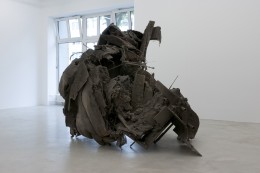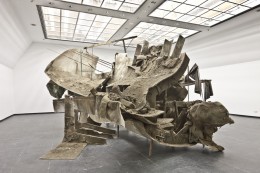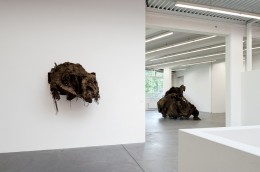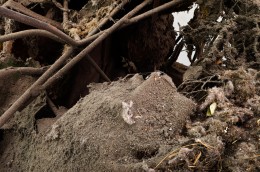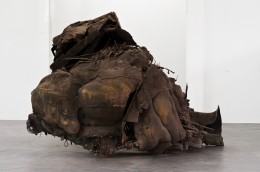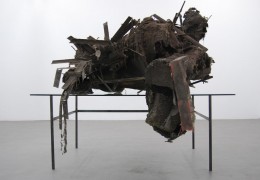“My goal is to achieve analogies for how I feel our world functions. Imagine yourself on the train, entering Brussels, passing behind all those old houses that have been completely transformed over time. New parts have been added to them, old parts have been torn down, a gabled roof has made way for a flat roof, windows with wood frames have been replaced by windows with plastic frames, and the design of the glass panes has changed. Some window and door embrasures have been sealed shut. New owners have modified these buildings in ways which were unforeseeable. The same is true of the room we are standing in, which has become my studio: It has gone through a great many changes since it was built over one century ago. It first served as the gym of this Neo-Gothic former boy’s school. Then, it was transformed into a puppet theater. Next, it became a neighborhood movie theater, and then, twenty years ago, it became my studio. This space bears the marks of all these changes. No one knows what transformation this space will undergo next. Or take the sea: It washes over the shore, leaves something behind, rolls over the shore over and over again, gradually building up a beach. Or take this conversation. We jump from one point to another. A conversation is unpredictable -it’s chaotic, one has no overview of it. I am likewise inspired by this working class neighborhood I live in, where everything is in a state of flux. The flux of reality is one of the principal subjects of my work.
I did not start out with this view of my work. Instead, I discovered the subject of my work once I had produced quite a bit of sculpture. I studied mathematics. Math uses the language of symbols. Images of things -which are, therefore, symbols of things- fail to seize the totality. That’s why I use analogy. Analogy stands so much closer to reality. My work does not include the least bit of symbolism. It is completely abstract.
When we look at an image, we instinctively aim to recognize something in it. My sculptures do not escape this entirely natural impulse on the part of the beholder. However, my works are built up in such a way that each impression one has of what one sculpture could refer to is dismantled as one walks around the work. Once you have finished walking around one of my sculptures, you cannot but conclude that it resembles nothing other than itself.
The materials I use are all abject: Dust, stomachs, innards, blood, hair. These materials lose their form and meaning once they are removed from their original context. Once this is achieved, these things become repellent. The act of reading symbols, which is ingrained in all of us, makes us overlook the actual appearance of the object. By dismantling this tendency of ours to work with symbols, I bring the viewer back to the object itself, and all its inherent qualities which symbolism bypasses. That is why I work with abject materials. Bataille said the abject was invented in order to declassify things. One declassifies by ignoring symbolism.”
Peter Buggenhout, from a conversation with Michaël Amy
